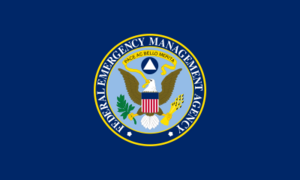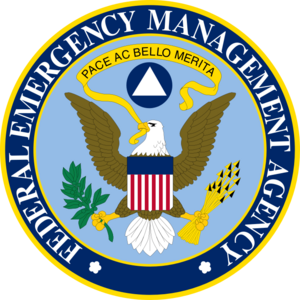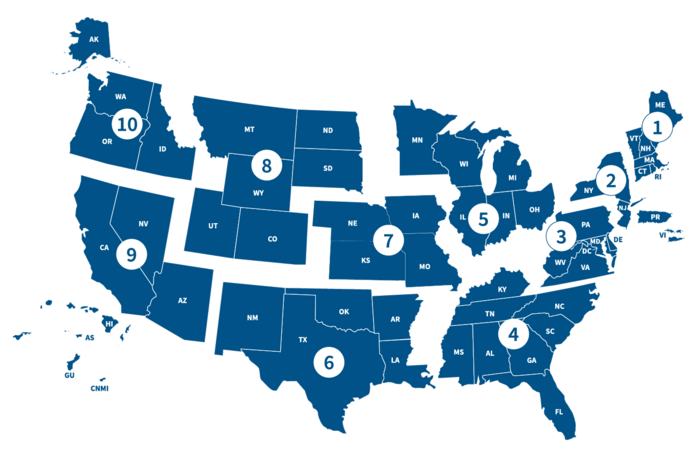Federal Emergency Management Agency facts for kids
 |
|
 |
|
| Agency overview | |
|---|---|
| Formed | April 1, 1979 |
| Jurisdiction | United States Department of Homeland Security |
| Headquarters | Washington, D.C., U.S. |
| Motto | Helping people before, during, and after disasters |
| Employees | 17,300+ (2025) |
| Annual budget | $33.08 billion (2025) |
| Agency executive |
|
| Parent department | U.S. Department of Homeland Security |
The Federal Emergency Management Agency (FEMA) is a government agency in the United States. It is part of the United States Department of Homeland Security (DHS). FEMA was created in 1979 by President Jimmy Carter.
FEMA's main job is to help when a disaster happens in the United States. This happens when a disaster is too big for local and state governments to handle alone. For FEMA to step in, the state's governor must declare a state of emergency. Then, they must ask the president for federal help. The only time this is not needed is if a disaster happens on federal land. An example is the 1995 Oklahoma City bombing at the Alfred P. Murrah Federal Building.
FEMA helps with disaster recovery on the ground. They also provide experts to state and local governments. They give money to rebuild and help people get low-interest loans. FEMA also funds training for emergency workers. They help non-federal groups provide housing for migrants.
Contents
History of Disaster Help
The U.S. government has been helping with emergencies for over 200 years.
Early Help (Before 1930s)
In the early 1800s, big fires hit Portsmouth, New Hampshire. In 1803, Congress passed a law to help merchants there. This was one of the first times the federal government helped after a disaster.
Between 1803 and 1930, over 100 special laws were passed for disaster relief. For example, after the Great Fire of New York (1835), merchants did not have to pay certain taxes. In 1893, Congress helped people injured when Ford's Theatre collapsed.
Different Agencies (1930s–1960s)
During the Great Depression in 1932, President Herbert Hoover created the Reconstruction Finance Corporation. This group lent money to banks and helped with disaster relief. It was the first organized federal disaster agency.
Later, the Bureau of Public Roads helped rebuild roads after disasters. The Flood Control Act of 1944 gave the U.S. Army Corps of Engineers power over flood control. This made them important in flood recovery.
Bringing Agencies Together (1973–1979)
In 1973, federal disaster help was moved under the Department of Housing and Urban Development (HUD). The Federal Disaster Assistance Administration was created within HUD. Before FEMA, many different government agencies handled disaster relief. Sometimes, over 100 agencies were involved in one disaster.
Over time, Congress added more types of disasters that could get help. Presidents also issued orders to expand aid. This led to many different agencies handling parts of disaster response. In 1978, FEMA was created to bring these efforts together. This was a big change.
FEMA as Its Own Agency (1979–2003)
FEMA officially started on April 1, 1979, by President Jimmy Carter.
FEMA took over many different disaster relief programs. These included federal insurance, fire prevention, and community preparedness. It also took over civil defense, which prepares for attacks.
FEMA helped with the toxic waste problem at Love Canal in New York. They also responded to the Three Mile Island accident, a nuclear power plant issue. These events showed FEMA could work, but also showed areas for improvement.
In 1993, President Bill Clinton chose James Lee Witt to lead FEMA. Witt made changes to make disaster recovery faster. After the Cold War ended, FEMA could focus more on preparing for natural disasters.
Congress continued to give FEMA more responsibilities. These included dam safety, earthquake safety, and helping with hazardous materials. FEMA also got involved in counterterrorism after the 1995 sarin gas attack on the Tokyo subway.
FEMA Under Homeland Security (2003–Present)

After the September 11 attacks in 2001, Congress created the Department of Homeland Security (DHS). This was to better coordinate agencies dealing with safety and disasters. FEMA became part of DHS on March 1, 2003. It became the Federal Emergency Management Agency again on March 31, 2007, but stayed within DHS.
Hurricane Katrina in 2005 showed that FEMA still had problems. A report found that money for disaster preparedness was often given less priority than money for fighting terrorism. This made the nation less ready for natural disasters like hurricanes.
After Hurricane Katrina, the Post-Katrina Emergency Management Reform Act of 2006 was passed. This made FEMA more independent within DHS. It also created a Surge Capacity Force. This force allows DHS to send more people to help FEMA when it is overwhelmed. This force has helped with hurricanes like Sandy, Harvey, Irma, and Maria. It also helped with the 2017 California wildfires.
In 2008, FEMA took over the Ready Campaign. This campaign teaches Americans how to prepare for emergencies. It tells people to build an emergency kit, make a family plan, and learn about different emergencies.
In 2013, after Hurricane Sandy, a new law allowed federally recognized tribes to ask the president directly for emergency help.
FEMA was in charge of getting medical supplies during the COVID-19 pandemic.
In 2025, FEMA faced budget cuts and lost employees. The Homeland Security Secretary, Kristi Noem, said she wanted to get rid of FEMA. The interim leader of FEMA, Cameron Hamilton, was dismissed after he spoke against eliminating the agency. David Richardson became the new interim leader.
How FEMA is Organized
FEMA is a major agency within the Department of Homeland Security. The FEMA Administrator reports directly to the Secretary of Homeland Security.
FEMA manages the National Flood Insurance Program. It also oversees the National Continuity Programs Directorate. This group plans for the government to keep working during emergencies.
FEMA also runs the Center for Domestic Preparedness. This center trains emergency responders.
FEMA gives out grants to state, local, and tribal governments. These grants help them improve security. This includes programs for homeland security and for protecting nonprofit organizations from threats. In 2024, FEMA managed over $3 billion in these grants.
Budget
In 2018, FEMA had a budget of $30 billion. This money is used to help different states during emergencies. FEMA publishes a list of how these funds are used each year.
Regions
FEMA divides the U.S. into 10 regions to manage its work:
- Region 1, Boston, MA – Serves CT, MA, ME, NH, RI, VT
- Region 2, New York, NY – Serves NJ, NY, PR, USVI
- Region 3, Philadelphia, PA – Serves DC, DE, MD, PA, VA, WV
- Region 4, Atlanta, GA – Serves AL, FL, GA, KY, MS, NC, SC, TN
- Region 5, Chicago, IL – Serves IL, IN, MI, MN, OH, WI
- Region 6, Denton, TX – Serves AR, LA, NM, OK, TX
- Region 7, Kansas City, MO – Serves IA, KS, MO, NE
- Region 8, Denver, CO – Serves CO, MT, ND, SD, UT, WY
- Region 9, Oakland, CA – Serves AZ, CA, HI, NV, GU, AS, CNMI, RMI, FM
- Region 10, Bothell, WA – Serves AK, ID, OR, WA
Work Teams (Cadres)
FEMA has 23 different types of work teams, called cadres. These teams have special skills to prepare for, respond to, and recover from disasters. Some examples include:
- Acquisitions (buying supplies)
- Civil Rights (ensuring fair treatment)
- Disability Integration (helping people with disabilities)
- Disaster Survivor Assistance (helping people affected by disasters)
- External Affairs (communicating with the public)
- Financial Management (handling money)
- Hazard Mitigation (reducing risks)
- Individual Assistance (helping individuals)
- Information Technology (tech support)
- Logistics (moving supplies)
- Public Assistance (helping public facilities)
Preparing for Disasters
FEMA's Mitigation Directorate focuses on actions taken before a disaster. Their goal is to find risks and reduce injuries, property loss, and recovery time. They have programs for floods, hurricanes, dams, and earthquakes.
FEMA works to make sure flood insurance is affordable for homeowners in flood-prone areas. This is done through the National Flood Insurance Program. They also work to prevent building in risky flood zones.
Grants are available to buy property for open space, fix buildings, and build tornado and storm shelters. The Hazard Mitigation Grant Program helps rebuild after a disaster in a way that reduces future damage.
FEMA Corps
FEMA Corps is a group of young people, aged 18 to 26. They are dedicated to disaster response and recovery. This program is a partnership between AmeriCorps NCCC and FEMA.
These Corps members work full-time for 10 months. They help with disaster response, recovery, and preparedness. They work in teams of 6 to 10 people. They live and travel together. Besides working with FEMA, they also do physical training and community service projects. Members receive a small amount of money for food and living expenses. After finishing their service, they can get an education award to help pay for college.
Managing Donations
FEMA has helped create a National Donations Management Program. This program makes it easier for companies and individuals to offer free help during disasters. It is a partnership between FEMA, relief groups, businesses, and state governments.
Criticisms of FEMA
FEMA has faced criticism for its response to several major disasters.
Hurricane Andrew (1992)
Hurricane Andrew hit Florida and Louisiana in 1992. FEMA was criticized for being too slow to respond. Many people were left homeless. Within five days, thousands of National Guard troops helped set up temporary housing. A report found problems with FEMA's management during this event.
FEMA had also been criticized for its response to Hurricane Hugo in 1989. Similar issues appeared again during Hurricane Katrina in 2005.
Florida Hurricanes (2004)
The Sun-Sentinel newspaper listed many criticisms of FEMA during four hurricanes that hit Florida in 2004.
- After Hurricane Frances, FEMA approved millions in claims for new furniture, clothes, and cars in areas not heavily hit. A Senate committee found that FEMA wrongly declared some areas disaster zones.
- FEMA paid for funerals for people whose deaths were not caused by the hurricanes. Some of these people were not even in Florida when they died.
Changes have been made to flood insurance due to rising sea levels and more severe storms. The National Flood Insurance Program (NFIP) used to have a "100-year floodplain" rule. It also gave large discounts for coastal homes. In 2019, a new program called Risk Rating 2.0 was introduced. This program prices a house based on its individual flood risk. It considers how far a house is from water and how often it floods. This means homeowners in high-risk areas will pay more for insurance. This change affects states like Florida with high hurricane risk.
Hurricane Katrina (2005)
FEMA received strong criticism for its response to Hurricane Katrina in August 2005. FEMA had staff ready, but many could not help directly. The huge number of people needing help overwhelmed rescue workers. Flooding and poor communication also made things worse. FEMA was criticized for its slow initial response and for not managing evacuees well.
The FEMA Director at the time, Michael D. Brown, was also criticized. He was later removed from leading the Katrina response and then resigned.
A report by the U.S. House of Representatives found many problems. It said FEMA lacked enough trained staff. It also said FEMA's systems for getting supplies were not good enough. The report concluded that FEMA's poor performance was "all but inevitable" due to long-standing weaknesses.
Many Katrina victims lived in temporary shelters or trailer parks. In 2007, ice ordered for Katrina victims, but never used, was melted down. In 2008, a CNN investigation found that FEMA gave away $85 million in goods meant for Katrina victims to other states.
Buffalo Snowstorm (2006)
FEMA was criticized for its response to a snowstorm in Buffalo, New York, in October 2006. FEMA stated that the governor had not asked for federal help. FEMA officials arrived three days after the storm. By then, there was already much damage to power lines, trees, and buildings.
California Wildfires (2007)
FEMA faced criticism when it was found that a press conference about the October 2007 California wildfires was staged. A FEMA official answered questions from FEMA employees pretending to be reporters. These questions were easy and made FEMA look good. Real reporters were given little notice and could only listen in.
Hurricane Maria (2017)
Hurricane Maria hit Dominica and Puerto Rico in September 2017. Maria was one of the strongest storms to hit the U.S. FEMA had prepared some supplies, but the island was still devastated. People reported that FEMA food packages included unhealthy snacks. FEMA was widely criticized for its response.
Puerto Rico lost almost all its power. The head of the U.S. Army Corps of Engineers explained that only about 14% of the power grid was working.
FEMA Administrator Brock Long said that Puerto Rico's politics made it harder for the federal government to send aid. Residents sometimes had to fill out paperwork in English, not Spanish. Brigadier General José J. Reyes of the Puerto Rico National Guard said the delay was also due to many storms hitting in a short time. He noted that transporting aid to an island is harder than to mainland areas.
Long resigned in March 2019 after criticism and an ethics complaint.
Hurricane Harvey (2017)
Hurricane Harvey hit southeast Texas in August 2017. It caused heavy flooding. Harvey was one of several hurricanes that affected the U.S. that year.
Some people had to wait up to two months for aid from FEMA. Technical problems delayed applications. Some residents were denied federal aid and had to fight to get help to rebuild their homes.
COVID-19 Pandemic (2020)
In early 2020, reports said the Trump administration was taking medical supplies from states and hospitals. These officials said they were not told how to get their ordered supplies. A FEMA representative said the agency was working to distribute supplies fairly.
However, several states reported issues. San Francisco's mayor said items they ordered were taken by FEMA and sold to the highest bidder. Massachusetts reported that 3 million masks they bought were taken by the federal government. The New England Patriots football team even used their team plane to bring masks from China to Boston.
Maryland's governor deployed the Maryland National Guard to guard a shipment of COVID-19 testing kits. The state of Colorado was about to buy 500 ventilators, but FEMA bought them first. The head of the Veterans Health Administration said 5 million masks meant for VA hospitals were taken by FEMA.
Central Texas Floods (2025)
By the time of the July 2025 Central Texas floods disaster, FEMA had fewer staff. Training had also stopped for months. This meant FEMA's response to this event was closely watched. A group of emergency management professionals stated that FEMA was not opening applications for key grants. These grants help pay for emergency staff and resources in many U.S. counties.
The Trump administration stated its goal was to reduce FEMA's federal role. They wanted individual states to handle more emergency management. There was concern that information flow within FEMA was being stopped. This made it harder for FEMA to work with states and other federal groups. A former FEMA administrator noted that out-of-state search and rescue teams are FEMA-trained and funded. She questioned what would happen if that funding stopped.
FEMA and States
Disasters can quickly become very expensive for states and local areas. Federal help becomes available when the president approves it, after a governor asks. The federal government usually pays 75% of the cost for governments to repair facilities. Local governments pay the rest. FEMA does not pay for buildings that were not properly kept up. It also does not pay to upgrade facilities.
Many states have their own disaster relief agencies. If a disaster is too big for a state to handle, the state's agency director advises the governor to declare a state of emergency. This allows the state to get federal help.
States also use agreements with other states, like the Emergency Management Assistance Compact. These agreements allow agencies to share resources. This helps them be better prepared for emergencies.
Local governments have the most immediate responsibility. Their ability to respond depends on:
- How much their tax money is affected.
- How much sales tax money they lose.
- Their access to other money.
- How much debt the city has.
Cities with strong finances and good agreements with other areas can respond better.
U.S. v. Parish of Jefferson et al
This court case gave FEMA the right to sue to get back money paid for flood insurance claims. This happens if the flood damage was caused by bad decisions by local officials or developers. The case also allows FEMA to sue local areas that do not follow flood plain management rules.
Leaders of FEMA
| Denotes acting capacity. |
| Portrait | Name | Start | End | Refs. | President | |
|---|---|---|---|---|---|---|
 |
James Hafer | May 1975 | April 1, 1979 | Gerald Ford (1974–1977) |
||
 |
Gordon Vickery Acting |
April 1, 1979 | July 1979 | Jimmy Carter (1977–1981) |
||
 |
Thomas Casey Acting |
July 1979 | August 1979 | |||
 |
John Macy | August 1979 | January 20, 1981 | |||
 |
Bernard Gallagher Acting |
January 20, 1981 | April 1981 | Ronald Reagan (1981–1989) |
||
 |
John McConnell Acting |
April 1981 | May 1981 | |||
 |
Jeff Giuffrida | May 1981 | September 1, 1985 | |||
 |
Robert Morris Acting |
September 1, 1985 | November 1985 | |||
 |
Julius Becton | November 1985 | June 1989 | |||
 |
Robert Morris Acting |
June 1989 | May 1990 | George H. W. Bush (1989–1993) |
||
 |
Jerry Jennings Acting |
May 1990 | August 1990 | |||
 |
Wallace Stickney | August 1990 | January 20, 1993 | |||
 |
William Tidball Acting |
January 20, 1993 | April 5, 1993 | Bill Clinton (1993–2001) |
||
 |
James Witt | April 5, 1993 | January 20, 2001 | |||
 |
John Magaw Acting |
January 20, 2001 | February 15, 2001 | George W. Bush (2001–2009) |
||
 |
Joe Allbaugh | February 15, 2001 | April 15, 2003 | |||
 |
Michael Brown | April 15, 2003 | September 12, 2005 | |||
 |
David Paulison | September 12, 2005 | June 8, 2006 | |||
| June 8, 2006 | January 21, 2009 | |||||
 |
Nancy Ward Acting |
January 21, 2009 | May 19, 2009 | Barack Obama (2009–2017) |
||
 |
Craig Fugate | May 19, 2009 | January 20, 2017 | |||
 |
Bob Fenton Acting |
January 20, 2017 | June 23, 2017 | Donald Trump (2017–2021) |
||
 |
Brock Long | June 23, 2017 | March 8, 2019 | |||
 |
Pete Gaynor | March 8, 2019 | January 14, 2020 | |||
| January 14, 2020 | January 12, 2021 | |||||
 |
Bob Fenton Acting |
January 12, 2021 | April 26, 2021 | Joe Biden (2021–2025) |
||
 |
Deanne Criswell | April 26, 2021 | January 20, 2025 | |||
 |
Tony Robinson Acting |
January 20, 2025 | January 22, 2025 | Donald Trump (2025–present) |
||
 |
Cameron Hamilton Acting |
January 22, 2025 | May 8, 2025 | |||
 |
David Richardson Acting |
May 8, 2025 | present | |||
Job Titles of FEMA Leaders
The head of FEMA has had different job titles over the years:
- Director of the Office of Emergency Preparedness (May 1975 – April 1, 1979)
- Director of Federal Emergency Management Agency (April 1, 1979 – April 15, 2003)
- This role was part of the President's Cabinet from 1996 to 2001.
- Director of Federal Emergency Management Agency and Under Secretary of Homeland Security for Emergency Preparedness and Response (April 15, 2003 – June 8, 2006)
- Director of Federal Emergency Management Agency and Under Secretary of Homeland Security for Federal Emergency Management (June 8, 2006 – March 31, 2007)
- Administrator of Federal Emergency Management Agency (March 31, 2007 – present)
More About FEMA
- History of homeland security in the United States
- United States civil defense
- Federal Civil Defense Authority
- FEMA photo library
- National Emergency Technology Guard
- Civil defense by country
- Civil Contingencies Secretariat, the UK's emergency management agency
- Emergency Preparedness Canada, Canada's emergency management agency
- National Disaster Medical System
- Disaster Medical Assistance Teams
- Disaster Mortuary Operational Response Teams
- Integrated Public Alert and Warning System
See also
 In Spanish: Agencia Federal de Gestión de Emergencias para niños
In Spanish: Agencia Federal de Gestión de Emergencias para niños






